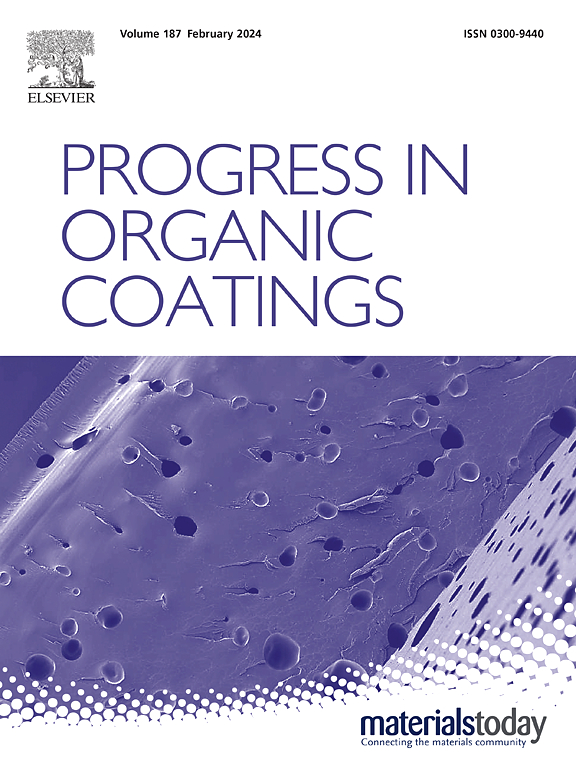硼酸对包装用溶液浇铸乙烯-乙烯醇薄膜形貌和透明度的影响
IF 7.3
2区 材料科学
Q1 CHEMISTRY, APPLIED
引用次数: 0
摘要
乙烯-乙烯醇(EVOH)因其优异的阻氧性能、机械强度和透明度而广泛用于包装应用。然而,这种聚合物固有的亲水性导致吸湿,从而导致在潮湿环境下性能下降。此外,EVOH薄膜在溶液浇铸过程中常发生白化现象,限制了其适用性。为了解决这些缺点,用硼酸(BA)交联对EVOH薄膜进行了化学改性。BA的引入控制了聚合物的结晶度,促进了聚合物链的重排,从而降低了结构的非均质程度,提高了屏障性能、力学性能和光学性能。此外,制备了不同BA浓度(0、1、3和5 wt%)的EVOH/BA薄膜。在BA浓度为1 wt%的情况下,由于中间相积累和多孔结构的形成,膜呈现明显的白化。随着BA含量的增加,膜的白化程度逐渐降低,当BA浓度为3wt %时可获得完全透明的膜。在此浓度下增强的交联密度也有助于改善屏障性能、热稳定性和机械强度。然而,由于过度交联,当BA浓度达到5 wt%时,性能略有下降。基于这些结果,3 wt%的BA浓度被认为是最佳的。这项工作为改善溶液铸造EVOH薄膜的结构完整性和功能性能提供了一种简单而有效的策略,为先进的包装应用提供了实际的潜力。本文章由计算机程序翻译,如有差异,请以英文原文为准。

Effects of boric acid on the morphology and transparency of solution-cast ethylene–vinyl alcohol films for packaging applications
Ethylene–vinyl alcohol (EVOH) is widely used in packaging applications owing to its excellent oxygen barrier properties, mechanical strength, and transparency. However, the inherent hydrophilicity of this polymer results in moisture absorption, which leads to performance degradation in humid environments. Furthermore, the whitening of EVOH films often occurs during solution casting, which limits their applicability. To address these drawbacks, EVOH films were chemically modified by crosslinking with boric acid (BA). The introduction of BA controlled the crystallinity and promoted polymer chain rearrangement, thereby reducing the degree of structural heterogeneity and enhancing the barrier, mechanical, and optical performances. Additionally, EVOH/BA films were fabricated with different BA concentrations (0, 1, 3, and 5 wt%). In the absence of BA and at a low BA concentration of 1 wt%, the film exhibited significant whitening owing to mesophase accumulation and the formation of porous structures. Upon increasing the BA content, the degree of film whitening progressively diminished, with a fully transparent film being obtained at a BA concentration of 3 wt%. The enhanced crosslinking density at this concentration also contributed to an improved barrier performance, thermal stability, and mechanical strength. However, a slight decline in performance was observed at a higher BA concentration of 5 wt% owing to excessive crosslinking. Based on these results, a 3 wt% BA concentration was considered optimal. This work represents a simple yet effective strategy for improving the structural integrities and functional performances of solution-cast EVOH films, offering practical potential for advanced packaging applications.
求助全文
通过发布文献求助,成功后即可免费获取论文全文。
去求助
来源期刊

Progress in Organic Coatings
工程技术-材料科学:膜
CiteScore
11.40
自引率
15.20%
发文量
577
审稿时长
48 days
期刊介绍:
The aim of this international journal is to analyse and publicise the progress and current state of knowledge in the field of organic coatings and related materials. The Editors and the Editorial Board members will solicit both review and research papers from academic and industrial scientists who are actively engaged in research and development or, in the case of review papers, have extensive experience in the subject to be reviewed. Unsolicited manuscripts will be accepted if they meet the journal''s requirements. The journal publishes papers dealing with such subjects as:
• Chemical, physical and technological properties of organic coatings and related materials
• Problems and methods of preparation, manufacture and application of these materials
• Performance, testing and analysis.
 求助内容:
求助内容: 应助结果提醒方式:
应助结果提醒方式:


